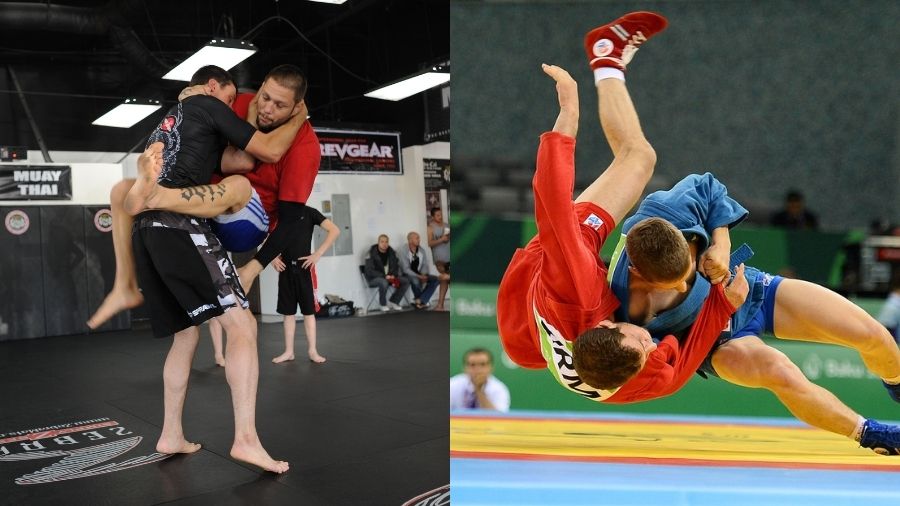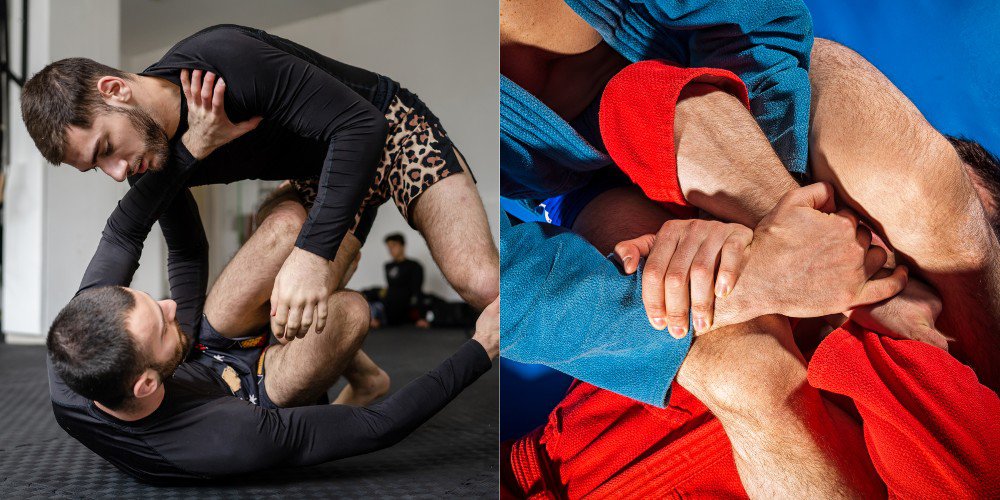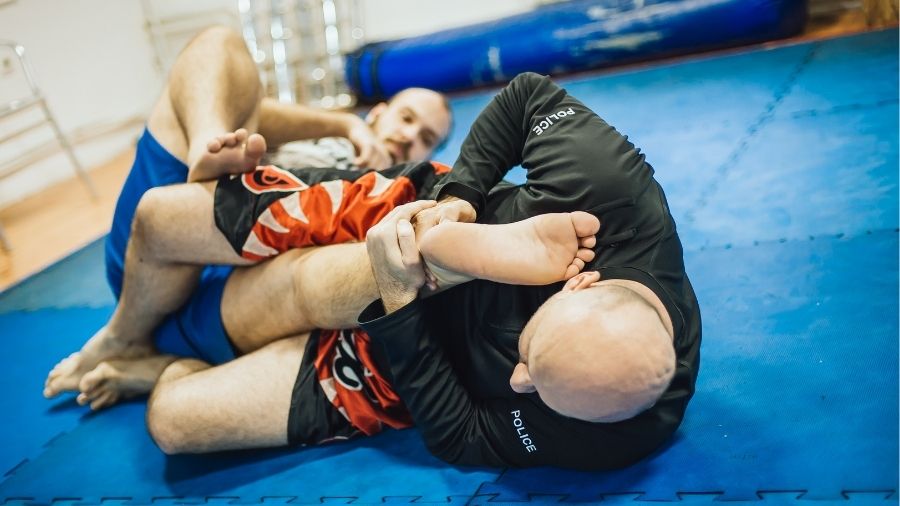Sambo and Brazilian jiu-jitsu are often compared as they are both grappling martial arts. As is often the case, each has advantages and weak points, but do you know where they excel and fall short?
BJJ and Sambo have standing and ground grappling and no striking in their sports versions, but the emphasis is different. Brazilian jiu-jitsu focuses almost entirely on ground fighting and is more methodical, whereas Sambo is more fast-paced, and throws and takedowns have a more critical role. Combat sambo is another version of the sport, including striking, making it quite different from both sports sambo and BJJ.
Sambo and jiu-jitsu are often compared across arenas like submission grappling and MMA, and people with the option to train in both often face the dilemma of choosing one.
What Is Sambo
Sambo is a Russian national combat sport that was developed in the 1930s in the Soviet Union as a system of hand-to-hand combat for the army. The name is an acronym for “self-defense without weapons” in Russian.
Since its inception, the idea of Sambo has always been effective above all else, and it shows. The style has no unique techniques or characteristics, but it takes effective moves from many other styles, and the final result is a style that is not quite anything else.
Vasili Oshchepkov and Viktor Spiridonov, credited as the style creators, worked independently to develop the early version of Sambo. Oshchepkov learned judo in Tokyo from its founder, Jigoro Kano, and later introduced it to Russia.
Spiridonov, on the other hand, was a wrestling and martial arts scholar (as well as a practitioner and World War I veteran) who gathered effective techniques and aspects from traditional wrestling styles found in the republics of the USSR.
Their students continued their efforts until 1938 when Sambo was declared an official martial art of the USSR.
Sambo has two distinctly different versions. Sports sambo is a grappling-only martial art that combines judo and wrestling, while combat sambo is a style where both striking and grappling are allowed, and it resembles MMA but with jackets and a different ruleset.
What Is BJJ
Brazilian jiu-jitsu is a combat sport created in Brazil focused almost entirely on ground dominance through leverage, positional control, and debilitating submission holds.
5 Step Blueprint To Build A BJJ Strength Workout To Demolish Your Opposition
Learn how to plan your strength training to maximize transfer to the mats.
BJJ’s history begins in the early 20th century in Brazil when Japanese judo and wrestling master Mistyuo Maeda traveled to the South American country to participate in challenge matches and teach students.
Many more masters and influences shaped jiu-jitsu during its first few decades, but Maeda and his students, the Gracie brothers Helio and Carlos, are credited as the most important.
The Gracies learned judo, which had a complex ground game (unlike modern judo) but focused mainly on throws.
Helio and Carlos started focusing predominantly on the ground fighting part and were also heavily influenced by the extremely popular Vale Tudo (free fights) fights at the time.
In time, the style evolved, new techniques and positions were added, and BJJ became a distinct style. While it was initially used for fights without rules, grappling-only competitions became increasingly popular.
Today, BJJ is a martial art with millions of practitioners worldwide. Most people train in the sports version that involves no striking, but the style is also taught as a self-defense system and is an integral part of modern MMA.
Key Differences Between BJJ and Sambo

Jiu-jitsu has two distinct versions, gi and no-gi, and removing the uniform for no-gi changes many small things in the grappling, like grips and available techniques. Still, in general, the two styles remain very similar.
Sports sambo and combat sambo, on the other hand, differ significantly. Sports sambo features only grappling, while combat sambo allows striking with all limbs, including headbutts, so it’s easy to see how this drastically changes all aspects of the style.
Main Focus
BJJ focuses almost entirely on ground grappling and submissions, with little attention given to takedowns. Sambo concentrates much more on takedowns and throws while having solid submissions and ground-fighting elements, but not as complex as in BJJ.
Combat sambo also has striking and focuses on combining striking and grappling.
The ideal approach in BJJ is methodical, and it goes through securing a dominant position and executing a submission. Sambo’s mindset is more aggressive and straightforward; ideally, victory is achieved as fast and decisively as possible.
Submissions
Jiu-jitsu has many submissions, including joint locks to all limbs, chokes, and strangulations. Sambo does not allow chokes, and only certain arm and leg locks are permitted. Combat Sambo does allow all submissions.
Ways To Directly Win A Match
In BJJ, you can win a match instantly by submitting the opponent. In Sambo, you can win by submission and executing a perfect throw or knocking the opponent out in combat sambo.
Competition Rules
Although BJJ has different rules in different organizations, we will use the most popular ruleset devised by the IBJJF.
BJJ Rules
- Matches are between 5 and 10 minutes in length, depending on the rank of the competitors
- Matches are contested on an open mat
- 2, 3, or 4 points are awarded for obtaining a dominant position, reversing an inferior one, or completing a takedown
- A match can be won by a submission or on points
- Different submissions are banned for different belt ranks/skill levels
Sports Sambo Rules
- Matches are 3-5 minutes long, depending on the age
- Matches are contested on an 8-meter wrestling mat
- Points are awarded for throws and hold-downs
- Throws and pins are scored with 1 to 4 points depending on several factors
- A match can be won by executing a perfect throw, a submission, by having an 8-point lead, or on points
- Arm and leg locks are permitted; chokes and strangles are not
Combat Sambo Rules
- In addition to the rules of Sports Sambo striking and chokeholds are allowed.
- Knockdowns also score points
- In addition to the other ways of winning, you can also win by knockout
Techniques

Jiu-jitsu excels on the ground, and most techniques are used on the mats. Positioning is equally vital in BJJ as submissions. BJJ uses different positions on the ground, like the mount, side control, back control, knee on belly, and most importantly, the guards.
A guard in jiu-jitsu is a position where you are on your back and use your legs and arms to control the distance between you and the opponent. It is not only a defensive position but also allows for submissions.
Fighting off your back is unique to BJJ and is not used in Sambo, where being pinned is frowned upon and earns points for the person on top, while BJJ practitioners often willingly assume a bottom guard position.
BJJ has many submissions, and the only holds-off limits in competition for high-level competitors are neck and spine cranks (some of which are allowed at pro-level no-gi events). The submissions include all possible joint locks, chokes, strangles, and other painful holds.
Sambo does have submissions, but the sports version bans chokes, so most sambists only deal with arm and leg joint locks. Sambo places much more attention on standing grappling, where wrestling-style takedowns and judo throws are used with equal emphasis and mastery.
In combat sambo, all restrictions are gone, and practitioners learn striking with all limbs and all kinds of submissions, including the chokes banned in sports sambo.
Equipment
The traditional uniform of BJJ is the gi, which consists of a jacket, drawstring pants, and a colored belt to hold the jacket closed and denote the wearer’s rank.
The other type of jiu-jitsu is called no-gi, where practitioners wear only BJJ rashguards and BJJ shorts. Some people practice both types, while others only choose only one of the two.
The sambo uniform for all rulesets is the same, although the rest of the gear differs between sports and combat Sambo. In both disciplines, the uniform is a jacket called a kurtka, similar to a judo gi, compression-style shorts, and wrestling shoes.
In combat, sambo competitors use a set of protective equipment, including:
- Head Guard
- MMA style gloves
- Ground guard
- MMA shin guards
- Mouthguard
Competitive Landscape And Availability
The discrepancy between popularity, accessibility, and the competitive scene is overwhelming when we consider the whole world, and BJJ boasts a significantly higher number of practitioners and competitions.
BJJ has become incredibly popular over the last 20 years, and there are academies worldwide. Since competitions are relatively safe compared to other combat sports, many people choose to compete regardless of age or physical shape.
On the high end, the IBJJF has elite competitions in the form of continental and world championships. For no-gi, the ADCC is the pinnacle, with the main event held every two years considered the Olympics of grappling.
Sambo, on the other hand, is much more limited in reach. In Russia and some countries in the former Soviet Bloc, it remains more popular than BJJ, but outside of this area of the world, there are few schools and even fewer competitions.
Sambo is structured similarly to international wrestling, and the best facilities and competitors are usually part of national teams. In general, the sport is geared toward young competitors in schools and universities, just like wrestling is, whereas most people who train BJJ are hobbyists.
Belt Ranks
| BJJ | Combat Sambo | Sport Sambo |
| The following is the IBJJF adult belt system: White Blue Purple Brown Black Red and black – 7th degree Red and White – 8th degree Red – 9th and 10th degree | In 2020, FIAS introduced the official Sambo belt ranks: White (rookie belt) Yellow Orange Green Blue Brown (master candidate) Black (master belt) | In 2020, FIAS introduced the official Sambo belt ranks: White (rookie belt) Yellow Orange Green Blue Brown (master candidate) Black (master belt) |
Sambo vs BJJ For Self-Defense
Both jiu-jitsu and Sambo are effective for self-defense and have strengths and weaknesses. In their pure sports versions, the apparent lack of striking is the biggest issue, but Sambo’s aggressive, takedown-heavy approach is better for a real-life situation.
While BJJ excels on the ground, you first need to take it there, and being on your back in a real situation is not advised.
Sambo focuses on takedowns and throws, and although there are fewer submissions, they are still more than you will ever need to incapacitate someone on the street.
In academies where self-defense BJJ is still taught, like in Gracie institutions, the art is much more realistic and better for self-defense.
But Combat Sambo is the undisputed king of real-life transferability, thanks to its incredibly liberal ruleset and diverse techniques, including all facets of fighting.
Sambo vs BJJ For MMA

BJJ and MMA have been inseparable since mixed martial arts became popular in the early 1990s, but if we judge the two sports by the number of top-level champions produced, Sambo wins.
Jiu-jitsu is necessary for every MMA fighter, and solid positional knowledge and submission defense are the minimum requirements. Also, many elite MMA fighters have come from a BJJ background and still do.
But a few of the greatest fighters of all time, like Fedor Emelianenko, Khabib Nurmagomedov, and Islam Makhachev—all boast the title of Combat Sambo World Champion and have often cited the Russian sport as their main tool for success.
Given the overall number of practitioners and places where both sports are available, Sambo’s achievements in MMA are even more impressive.
If we consider only sports sambo, BJJ is better for MMA, mainly because no-gi training is common, unlike in Sambo.
But Combat Sambo is the base for MMA because it’s almost the same, and all the striking, grappling, and combined elements transfer perfectly to MMA with some minor adjustments because of the uniform.
Should You Learn Sambo Or BJJ?

Most of you won’t have access to Sambo if we are realistic, so the choice is easy.
You can find jiu-jitsu academies everywhere in the developed world. Training is less explosive and less demanding on the body, and competitions are done so that many people of different shapes and ages can safely participate.
It is effective for self-defense, incredibly fun, and less harsh on the body than other martial arts while giving you fundamental combat skills. These are just a few reasons people choose to train in jiu-jitsu.
In the last few years, BJJ has grown immensely as a professional sport and is now a viable career option for athletes and instructors.
Sambo may be more practical for MMA and self-defense, especially if you also train in combat sambo. Still, it’s also more demanding, and most importantly, inaccessible for most people.
If you have access to both, then you may be in for a hard choice, and it will all come down to personal preference because both are too good to recommend just one.

